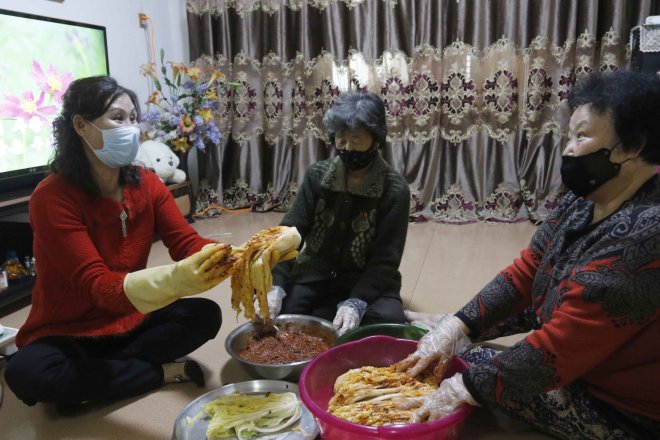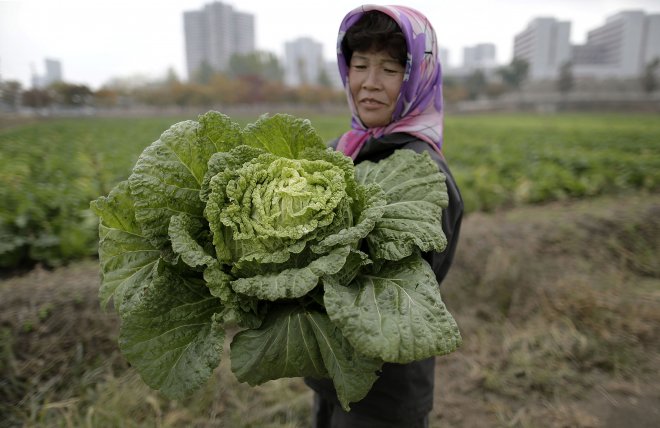
It’s a traditional, often communal event that happens every autumn when the weather grows colder, and it is central to Korean culture and cuisine: kimjang, the process of making kimchi, which is the country’s signature dish and a staple of nearly every meal.
But this year in North Korea, the combination of a drop in incomes and poor harvests of napa cabbage and radish – essential ingredients for the fermented, usually spicy dish – mean that there will be very little kimchi produced in the country this year, sources told Radio Free Asia.
“Given that our country is suffering from food shortages, the kimjang is supposed to make half a year’s worth of food for the residents,” a resident of the northern province of Ryanggang said on condition of anonymity for security reasons.
“Making kimchi by preparing cabbages, radishes, and various seasonings is an important yearly event, enough to call it the ‘Battle of Kimjang,’” she said, echoing the militaristic terms that the North Korean government assigns to important tasks that require communal labor. “But the poor residents have no choice but to give up their kimjang this year.”
In addition to poor harvests, the problem seems to be related to the COVID-induced closures of trade with China, a vital source of food and goods for North Korea. That in turn has meant thousands are earning far less or have lost their livelihoods entirely.
Though prices have increased in some areas of the country, inflation was less of a problem than dwindling incomes due to the COVID-19 pandemic.
Families are poorer this year and simply don’t have as much to spend on food, according to a source in the northeastern province of North Hamgyong, who requested anonymity to speak freely.
In years past, North Koreans could depend on their government-assigned jobs to provide them with ingredients for kimjang, but not so this year, the second source said.
“Some factories are supplying their employees with cabbage and radishes planted on the factory’s property, but it is only about five kilograms [about 11 pounds] per head of household,” she said.
“Kimjang should be finished by the beginning of November at the latest, but many residents can’t even start yet because vegetable farming did not go well this year, and the residents do not have enough money to buy the ingredients,” said the first source.
North Korea has faced this kind of kimchi crisis before.
In November 2020, RFA reported that North Koreans preparing for that year’s kimjang were scouring vegetable gardens to get the discarded cabbages and radishes that were less fresh and not fit to go to market. Sources at that time said that supplies of fresh vegetables were sent to military bases to make kimchi for the soldiers, leaving many citizens to do without.
Family Recipes
There is no set recipe for kimchi. Each family has their own method of making it, and every region of the peninsula has a local version it is known for. Though it can be bought premade in smaller quantities, most families make their own in preparation for the coming winter months.
During the communal act of kimjang, knowledge on how to make kimchi can be passed from maker to maker, or from one generation to another.
In addition to cabbages and radishes, it was difficult for the residents of North Hamgyong province to acquire other ingredients like chili pepper flakes and garlic, the second source said. She said those who were fortunate enough to have the vegetables are trying to make kimchi even if they do not have the proper spices.
“Due to the continuous deterioration of weather conditions, most vegetable farms did not fare well during the fall harvest,” she said. “The heavy rains hurt crops, ruining harvests of cabbages, radishes and red peppers.”
 In this Oct. 24, 2014 photo, a farmer carries a fully grown cabbage at the Chilgol vegetable farm on the outskirts of Pyongyang, North Korea. Photo: AP“Red peppers are one of the key ingredients of kimchi, but residents have no choice but to pickle kimchi without pepper,” she said.
In this Oct. 24, 2014 photo, a farmer carries a fully grown cabbage at the Chilgol vegetable farm on the outskirts of Pyongyang, North Korea. Photo: AP“Red peppers are one of the key ingredients of kimchi, but residents have no choice but to pickle kimchi without pepper,” she said.
There are non-spicy varieties of kimchi made without chili peppers, but the red, spicy varieties are more common.
The second source said that the shortage of vegetables in North Hamgyong should have been solved in 2019, when the country’s leader Kim Jong Un announced that the government would build a large-scale greenhouse farm there to ensure everyone in the province would have access to vegetables.
“But no one has seen where all the vegetables grown in the greenhouse farm are going,” she said, adding that residents of the city of Chongjin who cannot afford to buy fresh cabbages and radishes are trying to make kimchi with dried vegetables, but there aren’t enough of those either.
“At least, Chongjin City faces the sea, so some residents who make kimchi can pickle the vegetables with seawater,” she said.
Translated by Claire Shinyoung Oh Lee. Written in English by Eugene Whong.
